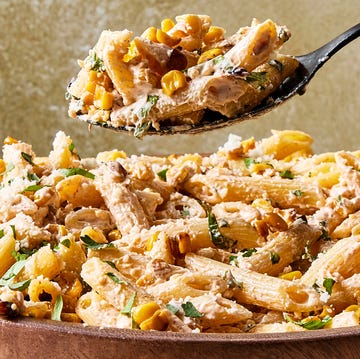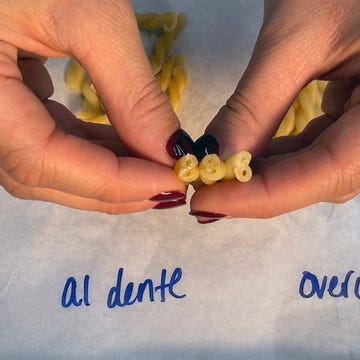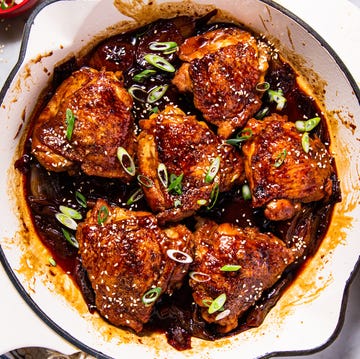Cooking a beautiful steak dinner on your stovetop is not only easy to do, but delivers ridiculously delicious results. I get it—it can be daunting if you've never attempted it before. But with my top tips and step-by-step guide, you’ll be well on your way to serving a steakhouse-worthy main to impress at your Valentine’s Day dinner or fancy dinner party. Pro tip: Add a side of garlic butter to make the steak even more magical.
How To Pan-Fry Steak
INGREDIENTS
- Neutral Oil: A neutral oil with high heat tolerance is the best choice for a pan-fried steak. You’ll need high heat to achieve the perfect, deep brown crust, and canola oil, vegetable oil, or avocado oil will help you get there without smoking out your whole kitchen.
- Boneless Ribeye Steak: The ribeye is the king of steaks. (Please don’t tell hangar steak I said that.) It has the perfect combination of fat and flavor and is widely available at almost any grocery store. I went with a boneless ribeye to ensure a quick cook time and easy reproducibility.
- Kosher Salt: Salt is crucial for the perfect flavor and texture. Before adding the steak to the skillet, season the outside (including the edges!) generously with salt. If you have time, let the salt sit on the steak for 45 minutes in the refrigerator, then remove the excess moisture with a paper towel. The combination of salt and a little air will help dry out the outer layer of the steak, helping you achieve the perfect exterior. If you don’t have 45 minutes to spare, simply pat the steak as dry as possible, season with salt, and cook as directed. This recipe was developed using Diamond Crystal kosher salt. If you use coarse Morton kosher salt, you’ll need 1 tsp. for a thick-cut (1 1/2") steak and about 1/2 tsp. for a standard-cut (1") steak.
- Freshly Ground Black Pepper (Optional): True steak lovers know that all you need to enjoy a perfectly cooked piece of meat is a little bit of salt, but there’s always room for a little razzle-dazzle in my opinion. Add a few grinds of black pepper to the steak before cooking to bring a pinch of heat to the party.
- Unsalted Butter: This is the restaurant technique that separates a good steak from a fantastic steak. Basting the top and sides of the steak after it’s flipped will help imbue the steak with butter flavor and aid in forming a delicious deeply brown crust.
STEP-BY-STEP INSTRUCTIONS
Pat steak completely dry with a paper towel. Season it all over with salt and refrigerate for 45 minutes (this is very optional). Pat dry again with paper towels.
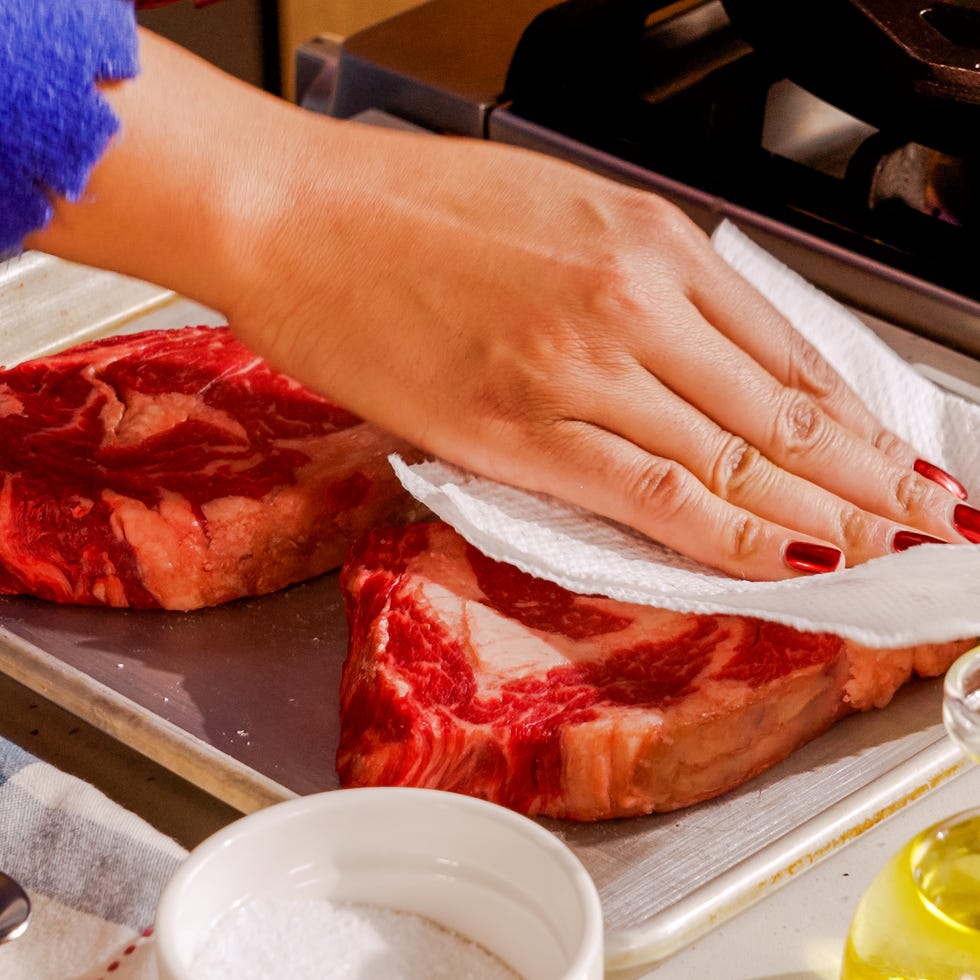
PHOTO: DAMIAN CALVO
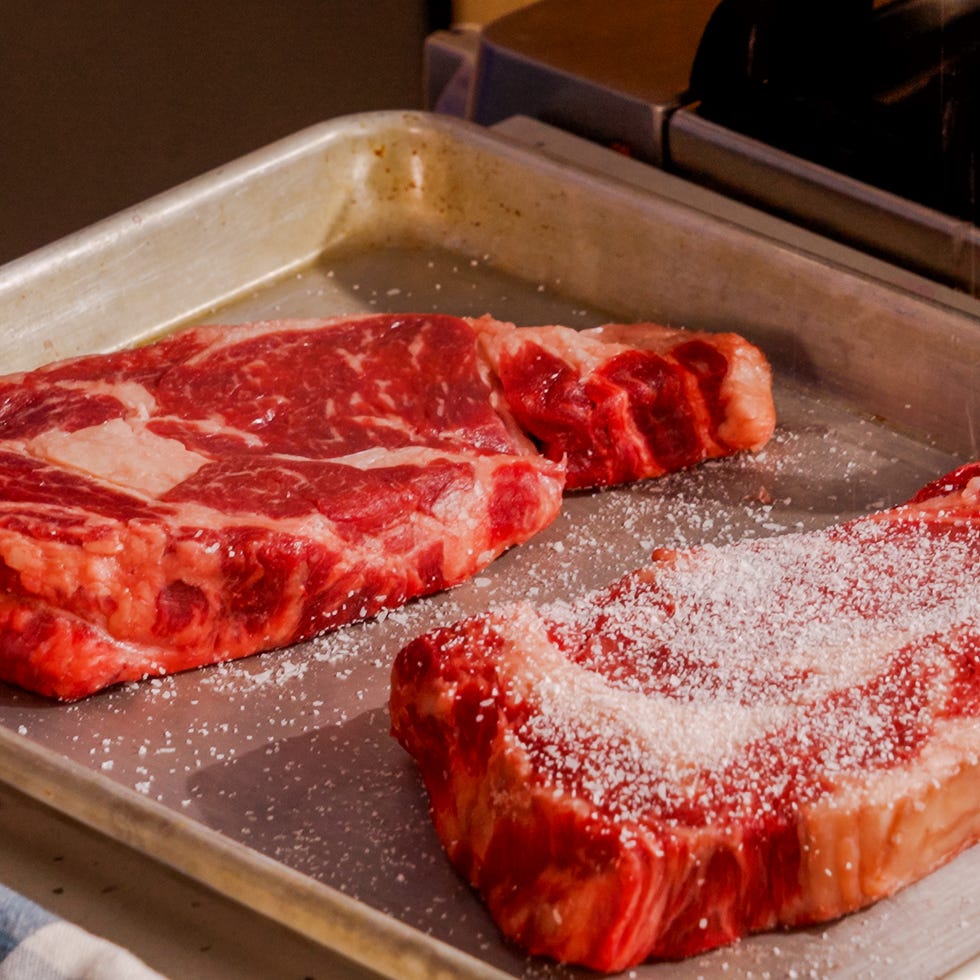
PHOTO: DAMIAN CALVO
Place a medium stainless steel or cast-iron skillet over medium-high heat. Avoid using a nonstick or aluminum pan. Nonstick pans typically have a coating that makes it tough to achieve the perfect exterior crust. Aluminum pans are horrible at retaining heat, which will lead to your steak sticking to the pan. Add some oil to the skillet, then season the steak with pepper on both sides.
When the oil is just about to smoke, add the steak. If you're cooking a thick-cut steak (around 1 1/2"), then cook for 5 minutes, then flip and add butter before reducing the heat to medium. If you're using a standard-cut steak (around 1"), cook for 2 to 3 minutes before flipping and adding the butter. Frequently baste steak with butter, by tilting the pan and spooning the melted butter over the steak.
For a thick-cut steak, cook another 5 minutes or until the internal temperature reaches 125° for medium-rare. For a standard-cut steak, it should take around 2 to 3 minutes instead.
Transfer the steak to a cutting board and let rest at least 5 minutes before slicing. Slice against the grain, then let it rain with sea salt.
Full list of ingredients and directions can be found in the recipe below.
Recipe Tips
- When do I remove the steak from the heat? This all depends on the cut of your steak, and your desired temp. For thicker cuts—like the ribeye used here—our steak was done after about 5 minutes on each side. Thinner cuts will only take about 2 to 3 minutes per side. The absolute best way to tell when your steak is done is to check the internal temperature with a meat thermometer. These are the temperatures your thermometer should read when it’s time to pull the steak from the pan. These temps may seem low, but it’s important to remember the steak will continue to cook as it rests, arriving at the perfect temperature as soon as you’re ready to slice. Here's our temperature guide.
- Rare: remove at 120°, steak will rise to 120° to 125°
- Medium-rare: remove at 125°, steak will rise to 130° to 135°
- Medium: remove at 135°, steak will rise to 140° to 145°
- Medium-well: remove at 145°F, steak will rise to 150° to 155°
- Use a THICK cut of steak: You want something at least 1" (1 1/2" is even better!). The Delish test kitchen prefers boneless ribeye steak because of all the marbled fat, but New York strip steak is another great option. If you want to do something thinner like a flank or skirt steak, you’ll need to reduce the time per side to avoid overcooking. Depending on thickness, it could be as quick as 2 or 3 minutes per side!
- Dry them off: For a really good crust sear, you want your steak's surface dry as hell—surface moisture is the enemy of crunch! The salt will draw out moisture as it sits, so just pat the steaks with paper towels before you add them to the pan and you are good to go.
- Let it rest: Season the steak with salt and let it rest (uncovered) in the fridge for around 45 minutes before cooking. It’s the best way to draw out even more moisture from the surface of raw steak.
- Get the pan hot: Only when the oil is shimmering and just about to smoke are you allowed to add the steak. Putting the steak in the pan before it's screaming hot will lead to overcooking and pathetic browning.
- Let it rest (again): You’ve heard it a thousand times before, but it's always worth repeating. Before you cut into that beautiful hunk of meat, let it hang out for at least 5 minutes, 10 if you can stand it. This step is important for ensuring an evenly cooked interior; plus, you don’t want to lose all of those amazing juices!
Variations
- Cowboy Steak: If you’re in the mood for a thick, bone-in ribeye, then this is your best bet. And as much as we love a juicy steak, the real stars here are the spicy suya butter and grilled red onion salad.
- Dirty Martini Steak Frites: This cocktail-inspired twist on the French bistro classic is as fun to make as it is to eat. Plus, you’ll have every excuse to sip a martini while you cook.
- Filet Mignon: Making tender filet mignon will make you feel like you’re dining in a 3-Michelin star restaurant.
Storage
Store any leftovers in an airtight container in the refrigerator for up to 4 days. When you're ready to reheat, read our guide on how to reheat steak for the perfect results.
PHOTO: MURRAY HALL; FOOD STYLING: TAYLOR ANN SPENCER

